From the In Box of Dr. Freex, July 7, 2000:
From
your Dracula vs. Frankenstein review:
"Director
Al Adamson has shown himself to be a crapmeister of the first
water. We shall hear from him again in these pages. You have
been warned!"
Unless
I'm forgetting something, you haven't reviewed another Adamson
film since DvsF, two years ago. Is there any chance whatsoever
you'll review another of Adamson's films?
Thanks,
Luc "Does 'Blood Heart' sound like a horror title to you?" French
And the response:
No,
not a chance in hell. Al Adamson shall never darken this doorstep
again.
... Ha Ha! I am KIDDING, of course. I'm contemplating a month's
worth of Bad Western reviews, and what have I sitting in my
review box? Not one, but TWO of Adamson's westerns.
Be careful what you wish for.
-fX ....'cause I wind up feeling the pain!
so you see, you can blame Luc French for this.
I know I do.
Not that Five Bloody Graves is necessarily
a bad movie; of all the Al Adamson movies I've yet seen, it's
the best looking and has a damn near coherent plot - but it's
still an Al Adamson movie.
I could probably end the review right there,
but what the hell.
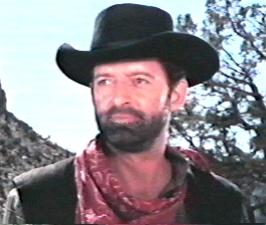 First,
let's meet our hero, Ben Thompson (Robert Dix), a former lawman
who currently wanders Goblin Valley in Utah (although the story
is set in Arizona), hunting down and killing Yaqui Indians.
The Narrator informs us that this is because the Yaqui chieftain
Santago killed Ben's wife, so Ben rides the Vengeance Trail.
First,
let's meet our hero, Ben Thompson (Robert Dix), a former lawman
who currently wanders Goblin Valley in Utah (although the story
is set in Arizona), hunting down and killing Yaqui Indians.
The Narrator informs us that this is because the Yaqui chieftain
Santago killed Ben's wife, so Ben rides the Vengeance Trail.
This is as good a time as any to mention the Narrator,
who introduces himself as Death (Gene Raymond). Death will crop
up over and over again throughout our story, referring to Ben
and other vengeance-driven men as "my earthly messengers"
and telling us how he rides alongside them "on my pale
horse". Like the wildly inappropriate, jazz-laden library
music score, Death does not know when to shut up (though, really,
who's going to tell him that?), jumping in at every lull in
the conversation, attempting to wax philosophical. You're going
to get just as tired of Him as you are the rest of the characters.
So. Ben first saves a man and a woman riding on
a single horse, pursued by Yaquis. They are Joe Lightfoot (John
"Bud" Cardos) and his squaw, Little Fawn (Maria Polo).
Joe is Santago's 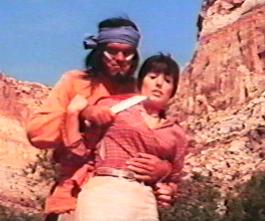 half-brother,
and the renegade wants Joe's wife for his own; thus they are
trying to escape. The two men bid each other vaya con dios
and part ways, so Ben can arrive in the nick of time to save
Nora (Vicki Volante) from an attack by a lone Indian (whom I
believe to be director Adamson).
half-brother,
and the renegade wants Joe's wife for his own; thus they are
trying to escape. The two men bid each other vaya con dios
and part ways, so Ben can arrive in the nick of time to save
Nora (Vicki Volante) from an attack by a lone Indian (whom I
believe to be director Adamson).
Ben challenges the Indian to a knife fight with
the taunt, "Yaqui has body of a woman," which, in
Indian sign language, is signified by moving the hands up and
down in a curvaceous manner normally only seen in cartoons.
One dead Indian later, we find out that Nora's husband, Dave
Miller, Went To Town and left her at their homestead alone.
Ben stands guard on their front porch overnight, until the man
of the house returns the next day, and boy, what a winner he
is..
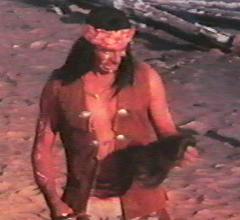 Dave
doesn't like Ben. Knocks the coffee out of his hand and says
not only has he never had Indian trouble, but he doesn't want
Ben's type around here, now git. Ben hangs around long
enough to warn Nora that she should get back to town until the
Indians calm down - but Dave strikes out to check his traps
instead. How many out there figure Dave and Nora will be dead
inside the next five minutes? Alright, hands down, you are all
correct. Extra points to everyone who figured that we would
also see an Indian holding some wigs aloft in the vain hope
that we would think they are bloody scalps.
Dave
doesn't like Ben. Knocks the coffee out of his hand and says
not only has he never had Indian trouble, but he doesn't want
Ben's type around here, now git. Ben hangs around long
enough to warn Nora that she should get back to town until the
Indians calm down - but Dave strikes out to check his traps
instead. How many out there figure Dave and Nora will be dead
inside the next five minutes? Alright, hands down, you are all
correct. Extra points to everyone who figured that we would
also see an Indian holding some wigs aloft in the vain hope
that we would think they are bloody scalps.
We should also meet two disreputable types, Clay
(Jim Davis) and Horace (Ray Young), who are the scumbags running
guns to Santago and his band. After their latest shipment, the
Indians pay off the thugs, then inform them they have two days
to get out of the territory or wind up supper for ants ("Ants
for supper?" wails the rather slow Horace, establishing
him as the picture's attempt at an Odious Comic Relief).
Ben comes upon the wounded Joe Lightfoot, who
was hunting for supper (not ants) when he was jumped by two
Yaquis ("They ain't around no more," says the wounded
man, smugly). Ben yanks the arrows out of Joe, then patches
him up after he's fainted. Once he's revived, the men head to
Joe's camp to rejoin Little Fawn. They really should hurry,
since Santago found the woman and staked her out on the ground,
spread-eagled - the "supper for ants" everybody keeps
talking about - and her luck is about to turn infinitely worse
as she is discovered by Clay and Horace.
 The
brothers Holcomb, in their late, lamented Webzine Wild Picture
(boys, I miss you!), make a good case in their Al Adamson article
that the director's films are defined by their "cruel moments",
moments meant to shock or outrage the audience. Moments meant
to stick in your memory, because they're so... well, cruel.
This scene certainly counts as one, as Clay first rapes (done
entirely with sound and close-ups of faces), then shoots the
helpless woman to death before Horace can have his turn. Even
when the slow-witted Horace tries to steal Little Fawn's silver
necklace, Clay takes it from him as a keepsake (and you just
know that's an error on the bad man's part).
The
brothers Holcomb, in their late, lamented Webzine Wild Picture
(boys, I miss you!), make a good case in their Al Adamson article
that the director's films are defined by their "cruel moments",
moments meant to shock or outrage the audience. Moments meant
to stick in your memory, because they're so... well, cruel.
This scene certainly counts as one, as Clay first rapes (done
entirely with sound and close-ups of faces), then shoots the
helpless woman to death before Horace can have his turn. Even
when the slow-witted Horace tries to steal Little Fawn's silver
necklace, Clay takes it from him as a keepsake (and you just
know that's an error on the bad man's part).
Ben and Joe arrive back at camp far too late,
and as Joe carries the body of his wife away to bury her, Death
informs us that he's just picked up a new earthly messenger,
yadda yadda yadda, ride my pale horse, blah blah blah. Time
to get to our next bunch of cannon fodder.
Um, characters, I meant characters.
Oh, hell - cannon fodder.
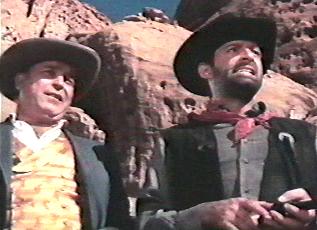 A
covered wagon pursued by Yaquis overturns, and it was an apparently
crowded wagon, as it disgorges preacher Boone Hawkins
(John Carradine! Yay!), pimp Jim Wade (Scott Brady - an actor
for whom I have genuine affection, so I could not help but think
of him as Scott Brady - Frontier Pimp!), his whore, the
high-strung Lavinia (Julie Edwards), madam Kansas Kelly (Paula
Beast from 20,000 Fathoms Raymond) and her whore,
Althea (Darlene Lucht), who is rather more high-minded. And
a few cowboys who are just there to be shot. Intruding on the
post-crash gunfight is Ben and Joe, who quickly turn the tide.
A
covered wagon pursued by Yaquis overturns, and it was an apparently
crowded wagon, as it disgorges preacher Boone Hawkins
(John Carradine! Yay!), pimp Jim Wade (Scott Brady - an actor
for whom I have genuine affection, so I could not help but think
of him as Scott Brady - Frontier Pimp!), his whore, the
high-strung Lavinia (Julie Edwards), madam Kansas Kelly (Paula
Beast from 20,000 Fathoms Raymond) and her whore,
Althea (Darlene Lucht), who is rather more high-minded. And
a few cowboys who are just there to be shot. Intruding on the
post-crash gunfight is Ben and Joe, who quickly turn the tide.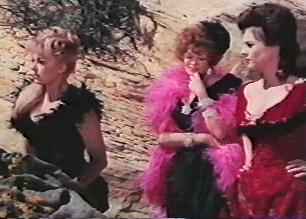
All these survivors proceed to walk to Tombstone
- the women riding Ben's and Joe's horses. They run into Clay
and Horace, and Clay cements his rep as the more despicable
of the two by informing Ben that he gives up his horse for "no
man or woman". Horace, however, gladly gives up his horse
for Althea.
During a rest stop, the drunken Clay sneaks up
on the bathing Lavinia and attempts to trade Little Fawn's necklace
for some R-rated sex, but only winds up getting slapped around
by Scott Brady - Frontier Pimp! After Scott Brady
- Frontier Pimp! harshly tells Lavinia to put some clothes
on and stop making a spectacle of herself, she catches an arrow
in the back. Scott Brady - Frontier Pimp! immediately
blasts the offending Indian into oblivion, and then has a good
cry over Lavinia's body. Oh, and Joe sees Little Fawn's necklace
in the unconscious Clay's hand. Told ya it was a mistake.
 Later,
when Ben is out scouting or exercising Death's pale horse or
some damned thing, Clay drinks himself into insensibility, and
Horace tries to slap him awake. This fails, but Horace finds
he likes slapping Clay, leading to Althea's cry of "You're
going to kill him!" Is it possible to kill somebody
by slapping them? Have my tax dollars been used to determine
this yet? In any case, Joe intervenes and slugs Horace. Horace,
not appreciating this, takes Althea as a hostage and demands
Joe disarm. He's about to shoot the half-breed when Boone -
John Carradine, remember? - informs him that can't be allowed.
And after reading from John 3:16, he blows the varmint away
with a derringer concealed behind his Bible.
Later,
when Ben is out scouting or exercising Death's pale horse or
some damned thing, Clay drinks himself into insensibility, and
Horace tries to slap him awake. This fails, but Horace finds
he likes slapping Clay, leading to Althea's cry of "You're
going to kill him!" Is it possible to kill somebody
by slapping them? Have my tax dollars been used to determine
this yet? In any case, Joe intervenes and slugs Horace. Horace,
not appreciating this, takes Althea as a hostage and demands
Joe disarm. He's about to shoot the half-breed when Boone -
John Carradine, remember? - informs him that can't be allowed.
And after reading from John 3:16, he blows the varmint away
with a derringer concealed behind his Bible.
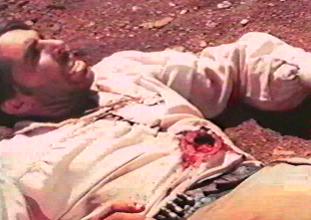 Clay
wakes up, reads the writing on the wall - or on his dead partner's
carcass - and rides off, the vengeful Joe in hot pursuit. After
a flying tackle from horseback knocks Clay out, the scoundrel
awakes to find himself tethered to the ground, just like his
earlier victim, as Joe brandishes the necklace in his face and
taunts him with the "supper for ants" speech which
seems to be very much in vogue that year. Joe's triumph is cut
short by a Yaqui bullet in his gut - which leaves a gaping and
surprisingly round hole in his shirt - and in a cruel moment
which is of a piece with the earlier one, rather than be cheated
of his vengeance, Joe stabs the bound Clay to death, and is
then skewered himself by multiple arrows.
Clay
wakes up, reads the writing on the wall - or on his dead partner's
carcass - and rides off, the vengeful Joe in hot pursuit. After
a flying tackle from horseback knocks Clay out, the scoundrel
awakes to find himself tethered to the ground, just like his
earlier victim, as Joe brandishes the necklace in his face and
taunts him with the "supper for ants" speech which
seems to be very much in vogue that year. Joe's triumph is cut
short by a Yaqui bullet in his gut - which leaves a gaping and
surprisingly round hole in his shirt - and in a cruel moment
which is of a piece with the earlier one, rather than be cheated
of his vengeance, Joe stabs the bound Clay to death, and is
then skewered himself by multiple arrows.
Ben gives up waiting for Joe's return and starts
climbing up some geological formation - God only knows why,
perhaps it's a shortcut - which sets up the winnowing down of
the rest of our cast. Boone catches a Yaqui arrow for Kansas
Kelly, who grabs the preacher's derringer and shoots his killer
(this is obviously the Magnum of derringers, it has such range)
before she herself is stabbed in the back. Next is Scott
Brady - Frontier Pimp!, who threatens to haunt Ben if he's
"stupid enough to waste time buryin' me". The top
of the mesa is reached, and it's time for Althea - who was sweet
on Ben, and it might have been getting reciprocal, but the script
is not exactly clear on that point - to die, and time for Ben
to shoot this last Yaqui, so a dummy can be thrown off a cliff.
This brings up the best story about the filming
of Five Bloody Graves, as referenced in David Konow's
book, Schlock-O-Rama.
Brief as the shot of the dummy falling may be in the final cut,
that dummy was a rental. Rather than pay the full price for
the dummy, Adamson climbed down the cliff, and then back
up with it. It's a sheer damned cliff - the man wuz awesome
serious 'bout saving money.
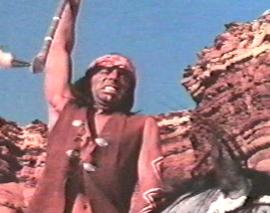 Well
this finally leaves only Ben and his quarry, Santago. All throughout
the picture, Santago has been sitting on nearby hills or plateaus,
pointing to his warrior's next target, or grimacing mightily.
If this seems like a leisurely way to lead a band of renegade
Indians - or an attempt to associate Santago with that other
disaffected figure in the picture, Death - all these might
be true. But the real reason Santago hasn't joined the party
until this point? He, too is played by John "Bud"
Cardos. Well, they are supposed to be half-brothers...
Well
this finally leaves only Ben and his quarry, Santago. All throughout
the picture, Santago has been sitting on nearby hills or plateaus,
pointing to his warrior's next target, or grimacing mightily.
If this seems like a leisurely way to lead a band of renegade
Indians - or an attempt to associate Santago with that other
disaffected figure in the picture, Death - all these might
be true. But the real reason Santago hasn't joined the party
until this point? He, too is played by John "Bud"
Cardos. Well, they are supposed to be half-brothers...
There's a big, nearly exciting knife fight that
ends up in a stream, and Santago 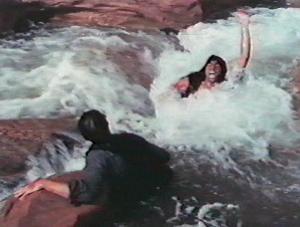 is
washed away to his doom or something. Ben buries his friends
(in defiance of the last wishes of Scott Brady - Frontier
Pimp!, but that's okay - Ben has now killed everyone in
a five mile radius) and, as he rides away, tips his hat to the
... ahem ....four.... graves. I could probably come up
with a rationale for the title, but I have my limits. The end.
is
washed away to his doom or something. Ben buries his friends
(in defiance of the last wishes of Scott Brady - Frontier
Pimp!, but that's okay - Ben has now killed everyone in
a five mile radius) and, as he rides away, tips his hat to the
... ahem ....four.... graves. I could probably come up
with a rationale for the title, but I have my limits. The end.
The major problem with Five Bloody Graves
is not, for once, the fact that Adamson made the movie piecemeal
over a number of years - no (although Adamson's usual bits-and-pieces
style is still evident), I fear the blame must be laid upon
the script by star Robert Dix - a conglomeration of Western
clichés presented with very little drama. Dix exhibits
only a rudimentary grasp of the concepts of rising and falling
action, foreshadowing or any of the other niceties one wishes
for in a film.
Employing a Narrator to simply advance the story
is always a warning sign of trouble ahead; if that much additional
glue is needed to add structure, someone is not doing their
job. Making Death the Narrator supplies the movie perhaps its
only claim to originality, but it is a Narrator nonetheless;
as Ben moons over the grave of his wife, Death tells
us of the tragedy that made the lawman who he is today - a severe
violation of dramatic law that is never even remedied in a flashback.
In other words, a character's defining moment happens offstage.
It worked in Greek Tragedy, but that is a dead art form. (except
Aristophanes. Aristophanes rules.)
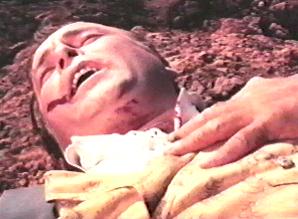 Curiously,
Ben is also alluded to in a number of instances in ways that
make him seem a driven, embittered individual - the doomed trapper
Dave Miller even sneers that he doesn't "want his kind here".
Most curiously because Ben never seems less than a kind, stand-up
feller with a facility for gunplay (not that it does anybody
else any good). Well, sort of kind... there is that moment
when Scott Brady, Frontier Pimp! is slapping the hell
out of Lavinia (until he is comically coldcocked by Kansas Kelly
crashing crockery on his cranium). When Althea expresses dismay
at the mistreatment of the prostitute, Ben smiles and says,
"He's always doing that. Most women like it." Which no doubt
immediately won over every female in the audience (and Lavinia's
shocked cry of, "You better not have hurt him!" only
improved matters, I'm sure).
Curiously,
Ben is also alluded to in a number of instances in ways that
make him seem a driven, embittered individual - the doomed trapper
Dave Miller even sneers that he doesn't "want his kind here".
Most curiously because Ben never seems less than a kind, stand-up
feller with a facility for gunplay (not that it does anybody
else any good). Well, sort of kind... there is that moment
when Scott Brady, Frontier Pimp! is slapping the hell
out of Lavinia (until he is comically coldcocked by Kansas Kelly
crashing crockery on his cranium). When Althea expresses dismay
at the mistreatment of the prostitute, Ben smiles and says,
"He's always doing that. Most women like it." Which no doubt
immediately won over every female in the audience (and Lavinia's
shocked cry of, "You better not have hurt him!" only
improved matters, I'm sure).
Characters are introduced, broadly painted, and
then killed in the setpieces which are the reason for the film's
existence - setpieces that are executed without bravado, and
which contain people that we have no reason to root for or care
about. No character actively changes - an essential
part of any story. The best-developed characters are the odious
villains Horace and Clay - they are each allowed to exhibit
more than one emotion - and when they die, the wind goes out
of the picture, the killings proceeding in a pretty much desultory
manner until we run out of movie. And characters.
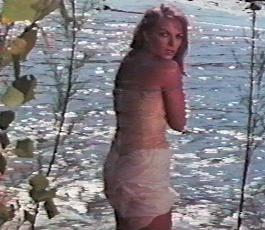 Another
oddness is the fact that everybody seems to know everybody else,
a cheap way of implying backstory without actually
providing backstory. It seems highly improbable that
so many of our characters should know each other under this
wide open sky, and it has the additional problem of dropping
the audience out of the story as they ponder how all these people
met, what their history might be... things about which the script
is not forthcoming.
Another
oddness is the fact that everybody seems to know everybody else,
a cheap way of implying backstory without actually
providing backstory. It seems highly improbable that
so many of our characters should know each other under this
wide open sky, and it has the additional problem of dropping
the audience out of the story as they ponder how all these people
met, what their history might be... things about which the script
is not forthcoming.
Sad, too, as the movie boasts a fine B-movie
cast - the pre-Dallas Jim Davis, Paula Raymond, John
Carradine (doubtless suffering a Stagecoach flashback
or two), Scott Brady (still looking like a woodshop teacher
who walked into auditions by mistake) and Adamson regulars Vicki
Volante and John "Bud" Cardos. Cardos is especially
good as the half-breed Joe, leading one to wonder why we haven't
seen more of him as the years went by (he's also got a very
interesting and varied IMDb filmography).
Still, I said the movie had a (rather) coherent
plot and was good looking, didn't I? This is one of the movies
that benefited from the recently-immigrated Vilmos Zsigmound's
camerawork. This, and the truly magnificent scenery on view
- there is not a single interior shot in the movie (didn't have
to rent lights that way) - lend it a more assured look than
many of Adamson's other impoverished productions. It's also
admirable that they managed to pull off the burning-down-the-homestead
bit for a measly couple hundred bucks. But as adept as he was
at zero-budget filmmaking, Adamson as a director was not strong
enough to force the script into a more individualistic work;
he could not supply the glue to patch together many disparate
chunks into an entertaining whole.
The character moments, where we're supposed to
see inside the characters, are played at the same level
as the action scenes. Every 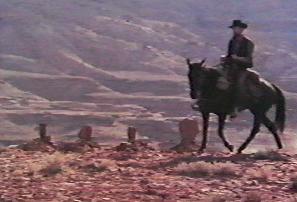 single
piece of film was probably used, as many of the connecting shots
are apparently footage of the stuntmen sauntering their ponies
back to position one. Cardos obviously shot one whole day of
nothing but reaction shots in Indian makeup to be used as needed
- rarely do they match the action or even time of day
of the scenes into which they are inserted. Some directors can
be given lemons and make lemonade. Adamson tended to simply
put the lemons on display.
single
piece of film was probably used, as many of the connecting shots
are apparently footage of the stuntmen sauntering their ponies
back to position one. Cardos obviously shot one whole day of
nothing but reaction shots in Indian makeup to be used as needed
- rarely do they match the action or even time of day
of the scenes into which they are inserted. Some directors can
be given lemons and make lemonade. Adamson tended to simply
put the lemons on display.
Though Five Bloody Graves lacks the unintentional
humor of Dracula vs. Frankenstein,
that's not wholly a good thing - without that, what we are left
with is an uninspired western that at least tries to
to be exploitatively mean-spirited, but it turns out to be a
case where the spirit is unwilling and the flesh is weak.